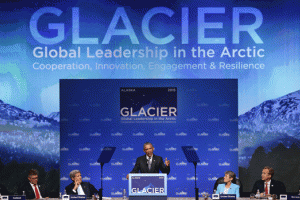October 19, 2016
BY PENNY GAGE
There is a stark divide between rural and urban Alaska, with 41 percent of the state’s residents residing in the city of Anchorage. Most communities are located off the road system, accessible only by airplane or boat. Supplying reliable, secure, and affordable energy is a challenge. Remote electricity systems, and even large cities concerned about storms and terrorist attacks, are increasingly looking to microgrid technology to meet their energy needs. A 2014 report by Navigant Research predicts that the global microgrid market will grow from $2.4 billion in 2014 to $5.8 billion in annual revenue by 2023, with a potential $10 billion share for microgrids in remote locations. Alaskan expertise can help guide this growth.
While Alaska has a goal of generating 50 percent of all electricity from renewable sources by 2025, expensive diesel-generated power currently constitutes 90 percent of rural communities’ energy mix. According to the Department of Energy’s Office of Indian Energy, due to transport costs and logistical challenges, rural Alaskan utilities companies can pay up to four times more for fuel than those elsewhere in the state. Costly state subsidy programs currently offset these communities’ energy costs, but in the state’s increasingly restricted fiscal environment these subsidies are less assured. The state’s over-reliance on revenues from the oil and gas sector led to a recession this year, while the global price of oil remains depressed.
Despite the challenges it faces, the Alaskan energy sector has excelled in one area in particular: microgrids—localized grids that can be disconnected from the traditional energy grid and that operate autonomously. In Alaska, microgrids are largely “islanded,” or located in remote communities. Alaska operates 12 percent of the world’s microgrids. In the state there are between 200-250 permanently islanded microgrids ranging from 30 kW to over 100 MW in size. While most of them run on costly diesel fuel, more than seventy of these microgrids integrate some type of renewable energy. About half of that is wind energy, and the rest is comprised of small hydro projects, biomass, and solar. Communities that integrate renewable energy see increased cost savings due to reduced consumption of expensive and less environmentally friendly diesel fuel.
Transatlantic cooperation opportunities
The experience cultivated in Alaska’s microgrid market is helping increase energy security and reduce costs, yet to move forward in a meaningful way, this expertise needs to be shared and built upon with partners in other regions, namely Europe. As other countries and communities improve upon these technologies and best practices, as a whole the microgrid market will grow. Three current projects highlight existing and possible opportunities for possible European-Alaskan microgrid cooperation. While endorsed by prominent groups such as the Arctic Council, at least one of these initiatives still lacks full funding and sufficient support from the Alaskan, US, and international communities.
The University of Alaska Fairbanks Alaska Center for Energy & Power (ACEP) has established the Global Applications Program (GAP) to assess the global opportunities for trade surrounding the use of energy systems in islanded grids. Through the program, Alaskans have been building technical expertise specific to microgrids with the goal of exporting this knowledge and building commercial ties with other countries. Additionally, the US Department of Commerce recently awarded a grant to the ACEP to establish the “Alaska Center for Microgrid Technologies Commercialization” as a means of helping new technologies survive the transition from experimentation to commercialization.
Under the US chairmanship of the Arctic Council (2015-2017), there has been an increased focus on microgrids. One of these projects is the Arctic Remote Energy Networks Academy (ARENA). ARENA seeks to increase human capacity through training and on-the-ground experience, and promote leadership through the creation of a knowledge-exchange program emphasizing the development, operation, and management of microgrids, incorporating renewable resources. ARENA involves a number of European nations via the Arctic Council—member states (Denmark, Sweden, Norway, Finland, and Iceland), and observer nations (the Netherlands, France, Poland, Germany, Spain, the United Kingdom, and Italy). ARENA is in a pilot stage in 2016, and, if fully funded, will launch in 2017 with webinars, onsite training, and field experience for participants.
Another project highlighted by the Arctic Council under the US chairmanship is a joint research program between the US Department of Interior and US Department of Energy’s National Renewable Energy Lab (NREL) focused on microgrids called the Remote Community Renewable Energy Partnership (RCRE). The project brings scientists and engineers together to ease the integration of high levels of wind power into diesel microgrids. RCRE is designing a modular, expandable, and more easily replicated smaller-scale renewable energy hybrid power system for use in the Arctic. The research could have positive implications throughout the world for those who live in remote Arctic areas, urban areas, and the developing world.
Recommendations for action
- Increase training for microgrid operation in remote and Arctic communities. The ARENA program is a start, but still lacks the funding necessary to be fully implemented in 2017. Long-term technical training should be coupled with financial assistance. Currently, this training is being conducted by organizations in Alaska such as the Alaska Village Electric Cooperative (AVEC), but as the benefits of increased training are noticed – financially and operationally—the private sector should take on this responsibility. If a company is paying for installation of wind turbines, a training plan should be a part of it, incorporated into the financing and cost. Feasibility studies of this model could be conducted in cooperation with industry partners.
- Inform policymakers and financiers about the need to both fund and allow for long-term capital plans to avoid an excess of deferred maintenance of microgrids down the road. Encourage developers and communities to work with the World Economic Forum’s Arctic Investment Protocol and private equity firms that operate in the Arctic to emphasize this need.
- Reduce reliance on subsidies by improving access to low-cost capital. Incentivize innovative public-private financing options, leveraging capital across borders. Revolving loan funds, and “green bank” concepts which leverage public funds to attract private investment, are increasingly good options for financing in rural communities.
- Increase opportunities for sharing best practices and facilitating partnerships between microgrid experts around the world. Encourage and fund peer-to-peer exchanges between urban and rural areas, developing countries, and established microgrid markets, to bridge knowledge gaps and transfer expertise in a growing and innovative field. Organizations such as the Islanded Grid Resource Center, the RCRE program, and the ARENA program can be effective in this effort, if properly funded.
Penny Gage is an Emerging Leaders in Environmental and Energy Policy (ELEEP) fellow with the Atlantic Council and Ecologic Institute.
*This article initially appeared on the Atlantic Council's New Atlanticist Blog.
Photo: Jonathan Ernst, Reuters
Location:
Alaska
Publication Type:






